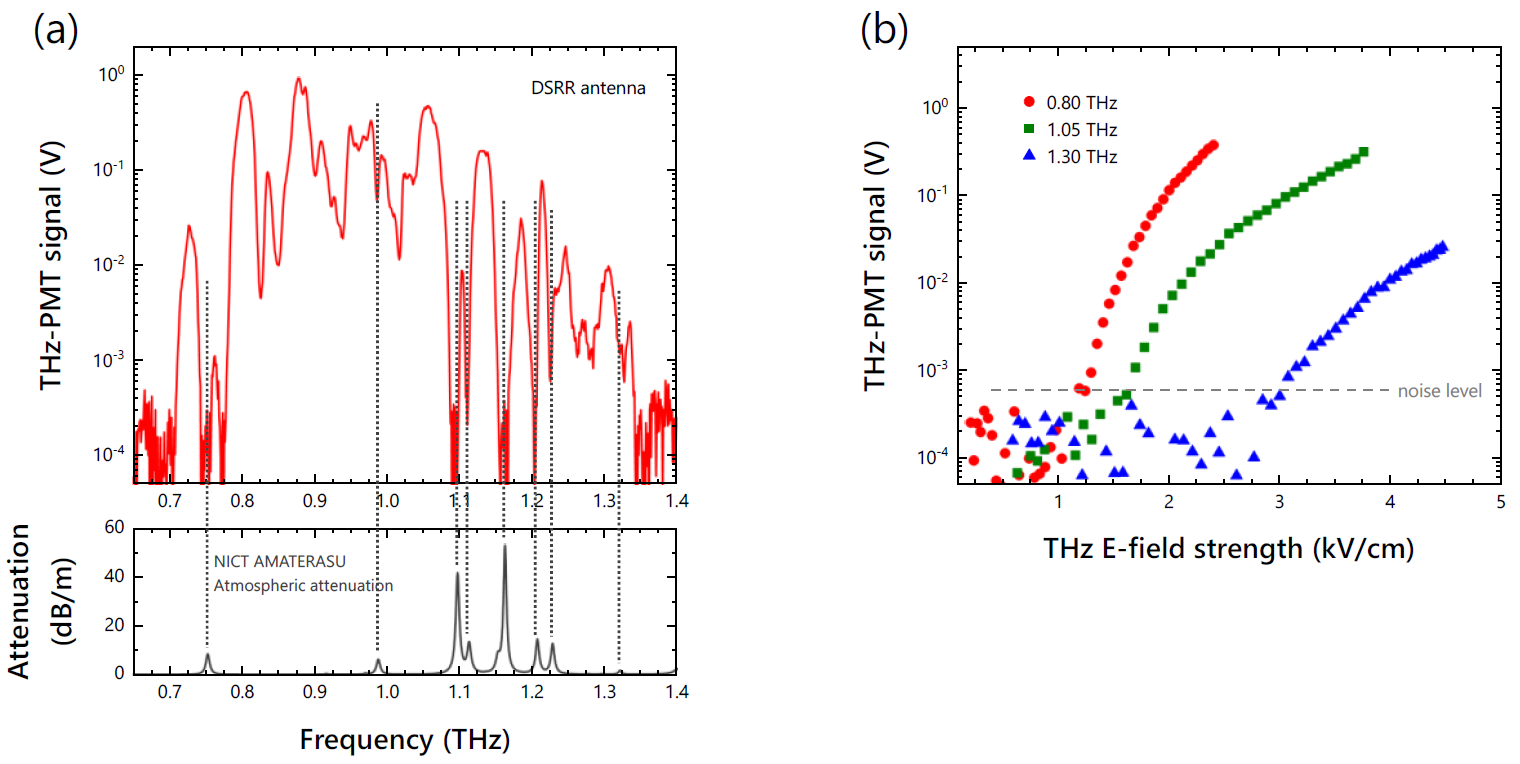| PREVIOUS PRESENTATION | BACK TO PROGRAM OVERVIEW | NEXT PRESENTATION |
Characterizing spectral sensitivity of THz photomultiplier tubes by an injection-seeded THz-wave parametric generator
Yuma Takida1, Naoya Kawai2, Hisanari Takahashi2, Kota Katsuyama2, Tobias Olaf Buchmann3, Matej Sebek3, Simon Jappe Lange3, Peter Uhd Jepsen3, Hiroshi Satozono2, Takayuki Omura2, and Hiroaki Minamide1
1RIKEN Center for Advanced Photonics, RIKEN, Sendai, Miyagi 980-0845, Japan
2Hamamatsu Photonics K.K., Hamamatsu, Shizuoka 438-0193, Japan
3Department of Electrical and Photonics Engineering, Technical University of Denmark, DK-2800 Kongens Lyngby, Denmark
A THz photomultiplier tube (THz-PMT), which utilizes a resonant metasurface antenna to convert THz waves into electrons, is attracting attention as a new THz-wave detector [1]. Since its working principle is based on THz-driven field electron emission in a metasurface antenna, THz-PMT exhibits a fast pulse response time of a few nanosecond and nonlinear input-output characteristics according to the Fowler-Nordheim relation with respect to the electric field strength of the incident THz wave. Therefore, since it is possible to emphasize and detect minuscule changes in the electric field strength of incident THz waves, it is expected to be applied to various applications of high-sensitive THz-wave spectroscopy [2].
In this study, we perform the characterization of the spectral sensitivity of THz-PMTs by using a high-peak-power, narrowband, frequency-tunable THz-wave source of injection-seeded THz-wave parametric generator (is-TPG). Fig. 1(a) shows a schematic of the experimental setup for the characterization of the spectral sensitivity of THz-PMT with the is-TPG source. The is-TPG is capable of producing high-peak-power, narrowband THz-wave pulses with continuous and wide frequency tunability [3]. In this study, the frequency range from 0.60 to 1.50 THz was used to match the frequency response of the THz-PMT. The THz-wave frequency linewidth of the is-TPG was measured to be less than 4 GHz. The repetition rate of the is-TPG source is given by the repetition rate of the pump laser at 200 Hz. The gain medium of the is-TPG was a MgO-doped congruent lithium niobate (MgO:LN) crystal with a single Si prism coupler attached on the side surface of the MgO:LN crystal. Thin-film attenuators with a fixed transmittance and a pair of two wire-grid polarizers were used for coarse and fine adjustment, respectively, of THz-wave E-field strength applied to THz-PMT. Fig. 1(b) shows the estimated temporal electric-field waveform of the multi-cycle THz-wave pulse from the is-TPG source at 1.05 THz. The peak electric-field strength of 9.3 kV/cm was calculated by measuring pulse energy, beam size, and pulse width using a calibrated pyroelectric detector, THz-wave imager, and up-conversion-based cross-correlation technique [3], respectively.

Figure 1: (a) Schematic experimental setup for characterization of spectral sensitivity of THz-PMT with is-TPG source. (b) Estimated temporal electric-field waveform of the multi-cycle THz-wave pulse from is-TPG source at 1.05 THz.
Fig. 2(a) shows the measured THz-PMT signal amplitude as a function of THz-wave frequency. The metasurface antenna and substrate of the THz-PMT device used in this study were double split-ring resonator (DSRR) and high-resistivity silicon, respectively. Although sharp dips due to absorption lines of atmospheric water vapor were observed as shown by the dashed vertical lines in Fig. 2(a), the measured THz-PMT signal amplitude was affected by frequency-dependent antenna resonance and etalon effect within the silicon substrate, resulting in a complex spectral sensitivity characteristic. Fig. 2(b) shows the input-output characteristics measured at three different frequencies of 0.80, 1.05, and 1.30 THz. These three frequencies were selected because the signal amplitude of the THz-PMT showed local maximum values at these frequencies. The detection threshold of the THz-PMT is frequency-dependent due to the resonant characteristics of the DSRR metasurface antenna, and measured as 1.3, 1.6, and 3.0 kV/cm at 0.80, 1.05, and 1.30 THz, respectively. Note that the measured input-output characteristics are described well by the Fowler-Nordheim relation. In summary, we have been working on the characterization of the spectral sensitivity of the THz-PMT detector by using a frequency-tunable is-TPG source. Our results show that the THz-PMT with the DSRR antenna shows a complex spectral sensitivity with nonlinear input-output characteristics owing to the metasurface antenna resonance and the interference effect within the substrate. We believe that the combination of THz-PMT detector and is-TPG source will open new THz-wave applications, especially in industrial fields.

Figure 2: (a) Measured THz-PMT signal amplitude as a function of THz-wave frequency. Absorption lines of atmospheric water vapor are indicated by vertical dashed lines. (b) Measured input-output characteristics of THz-PMT for three different frequencies.
References
[1] S. Lange et al., Laser Photonics Rev. 18, 2300417 (2024)
[2] N. Kawai et al., The 2023 48th International Conference on Infrared, Millimeter and Terahertz Waves (IRMMW-THz 2023), Tu-PM1-1-1, Montreal, Canada (Sep. 19, 2023)
[3] Y. Takida et al., Opt. Express 30, 11217 (2022)
